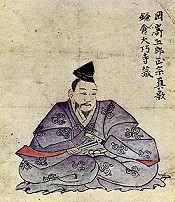Masamune | |
|---|---|
| 正宗 | |
 Masamune Portrait | |
| Personal details | |
| Born | c. 1264 Japan |
| Died | 1343 (aged 79) |
| Children | 1, Hikoshiro Sadamune[1] |
| Occupation | Swordsmith |
| Influenced |
|
Gorō Nyūdō Masamune (五郎入道正宗, Priest Gorō Masamune, c. 1264–1343)[2] was a medieval Japanese blacksmith widely acclaimed as Japan's greatest swordsmith. He created swords and daggers, known in Japanese as tachi and tantō, in the Sōshū school. However, many of his forged tachi were made into katana by cutting the tang (nakago) in later times ("suriage"). For this reason, his only existing works are katana, tantō, and wakizashi.[3][4] No exact dates are known for Masamune's life. It is generally agreed that he made most of his swords between 1288 and 1328. Some stories list his family name as Okazaki, but some experts believe this is a fabrication to enhance the standing of the Tokugawa family.[5]
Masamune is believed to have worked in Sagami Province during the last part of the Kamakura period (1288–1328), and it is thought that he was trained by swordsmiths from Bizen and Yamashiro provinces, such as Saburo Kunimune, Awataguchi Kunitsuna and Shintōgo Kunimitsu. He was the father of Hikoshiro Sadamune,[1] also a famous Sōshū master.
An award for swordsmiths called the Masamune Prize is awarded at the Japanese Sword Making Competition. Although not awarded every year, it is presented to a swordsmith who has created an exceptional work.[6][7]
- ^ a b Cite error: The named reference
son-hikoshirowas invoked but never defined (see the help page). - ^ Fujishiro, Yoshio; Fujishiro Matsuo (1935). Nihon Toko Jiten. p. 386.
- ^ 検索条件:「国宝・重要文化財(美術工芸品)」、「正宗」、「工芸品」 (in Japanese). Agency for Cultural Affairs, Government of Japan. Retrieved 7 March 2024.
- ^ 相州伝の名工「正宗」. Nagoya Japanese Sword Museum Touken World.
- ^ Fujishiro, Yoshio; Fujishiro Matsuo (1935). Nihon Toko Jiten. p. 387.
- ^ Japanese Sword Making Competition Archived January 16, 2007, at the Wayback Machine THE MIYAIRI SCHOOL Archived January 16, 2007, at the Wayback Machine
- ^ Body and Soul: An Interview with Master Swordsmith Miyairi Norihiro